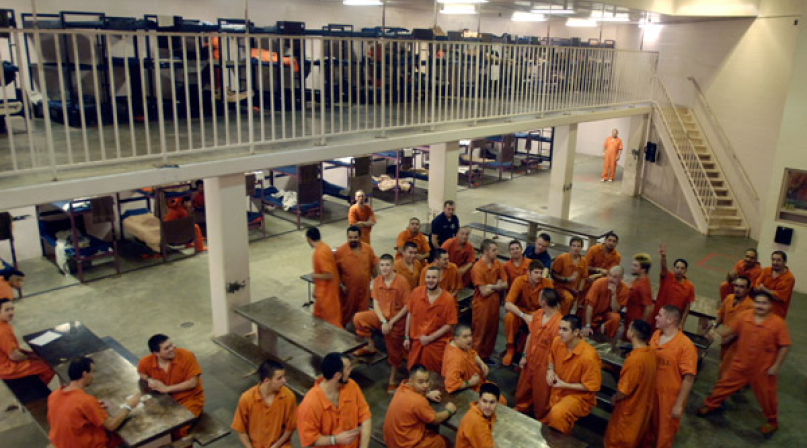Pretrial population and costs put county jails at a crossroads
Upcoming Events
Related News

Counties own 87 percent of all local jail facilities in the United States — many of them overcrowded — yet they have very little say in determining who is detained and how long they stay.
Sixty-seven percent of the population in county jails is pretrial, detainees who have been charged with committing a crime not yet adjudicated, according to a new NACo research report, County Jails at a Crossroads: An Examination of the Jail Population and Pretrial Release. In some counties, it’s as high as 75 percent.
The research is based on a survey of more than 1,300 county jails conducted between March and April 2015 with the support of the American Jail Association. It examines the pretrial population in county jails and their role in pretrial release and supervision.
Jail costs and populations are inherently related, and 44 percent of responding county jails reported that lowering jail costs is currently one of their top priorities. However, the courts determine who is eligible for pre-trial release, limiting county jails and County Boards in their ability to lower costs and reduce jail populations.
Many county jails use a risk assessment when admitting or booking someone into jail following arrest, which allows them to evaluate the person’s likelihood of committing a new offense and jeopardizing community safety.
Low-risk inmates could be released pending trial, easing jail overcrowding and thereby reducing the cost of detention to counties. Forty-two percent of county jails responding to the NACo survey operate at, above or near capacity. When a jail is approaching its capacity, it loses flexibility in terms of both space and personnel to accommodate even small increases in population.
County jails are doing what they can to manage the pretrial population. Community-based supervision programs allow jails to shift supervision and custody to the community. Thirty-two percent of responding county jails have a program that releases pretrial detainees from custody and supervises them in the community.
In addition to pretrial supervision programs, detainees who have been charged but not yet faced trial, may also be eligible for community-based supervision through electronic monitoring, home arrest and work-release programs — as well as behavioral health treatment and physical health care treatment.
However, county jails are limited in their capacity to make use of these programs. Despite the prevalence of community supervision programs in county jails, in most cases a judge authorizes the jail to place pretrial detainees into programs that result in release from confinement and placement in community supervision. Because jails primarily derive pretrial release authority from the courts, the judicial system maintains a key role in the ability of jails to manage not only the pretrial population in jail, but also the total jail population.
Without effective population management in collaboration with the court, jails may continue to feel pressure on jail capacity and difficulty controlling corrections costs.
From elected leaders to philanthropists, there is an increasing focus on improving the efficiency and effectiveness of county justice systems, including reducing the county jail population and rethinking the bail system that guides whether someone arrested can be released from jail while their case moves through the court system. These two issues in county justice systems are connected because of the large pretrial population in county jails. The purpose of bail is to ensure that a defendant will appear for court and to protect public safety.
The current bail system in most counties primarily uses bail schedules or financial conditions that guide pretrial release decisions by setting a dollar amount based on the charge against the defendant. Thus, defendants with the money to make bail can fund their release from jail while those defendants without funds remain in jail.
The dynamic between courts and jails during pretrial is central to understanding the prevailing population and cost trends within county jails. Assessing the impact of current pretrial release policies and decision making on the county justice system will continue to position counties in leading the way in pretrial justice.
Attachments
Related News

County officials moonlight in search and rescue roles
For some county officials, participating in search and rescue operations is another way to serve their communities, and make it safer for people to enjoy natural recreation resources.

SUPPORT Reauthorization Act of 2025: What it means for counties
On December 1, the bipartisan SUPPORT for Patients and Communities (SUPPORT) Reauthorization Act of 2025 (H.R. 2483) was signed into law. The reauthorization renews vital federal funding for programs that seek to prevent opioid overdoses and expand treatment and recovery options.

DHS releases FY 2026 funding opportunities for World Cup and Counter-UAS grants
The U.S. Department of Homeland Security (DHS) and the Federal Emergency Management Agency (FEMA) have released the FY 2026 Notices of Funding Opportunity (NOFOs) for two major new homeland security grant programs: the FIFA World Cup Grant Program and the Counter-Unmanned Aircraft Systems (C-UAS) Grant Program.